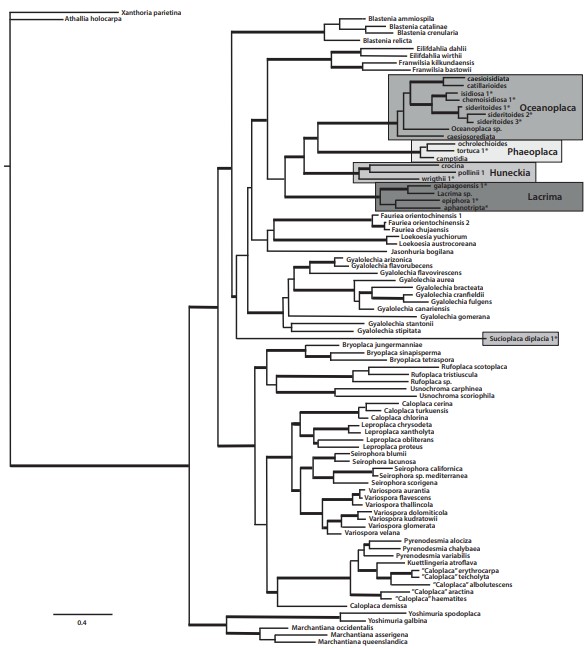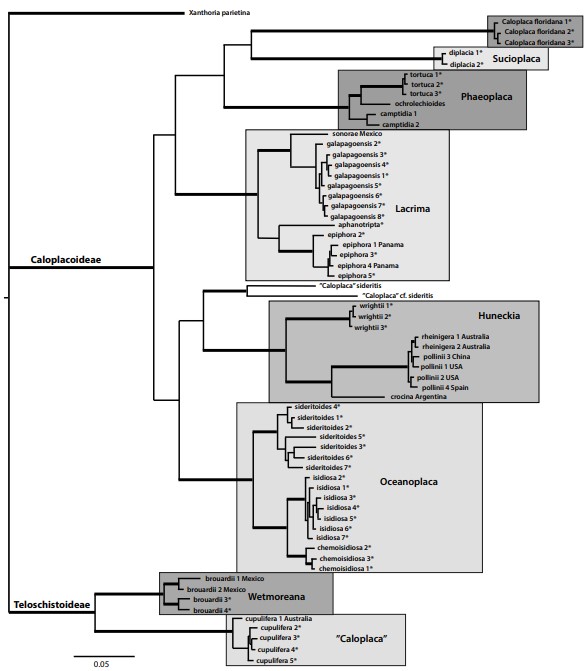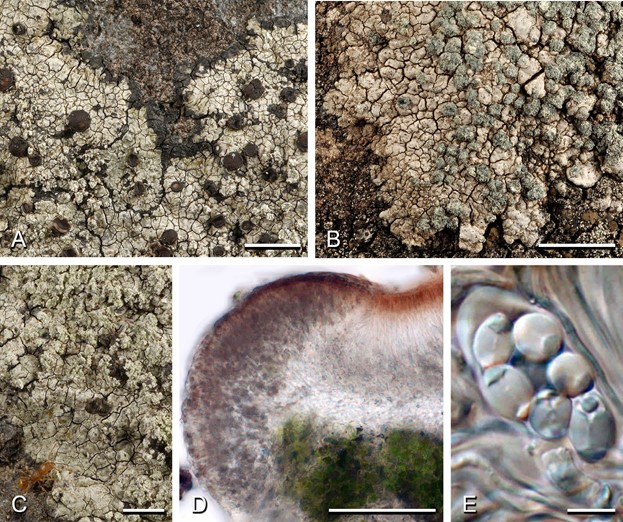Sucioplaca diplacia (Ach.) Bungartz, Søchting & Arup, comb. nov. (Figs 1–2, 17)
MycoBank number: MB 836962; Index Fungorum number: IF 836962; Facesoffungi number: FoF 13615;
Basionym: Lecanora diplacia Ach., Syn. meth. lich. (Lund):154. 1814; MycoBank MB 388093. Caloplaca diplacia (Ach.) Riddle, Memoirs of the Brooklyn botanical Garden 1: 113. 1918; MycoBank MB 381493.
Description. Thallus rimose to rimose-areolate, thin to strongly thickened, ± effuse, but typically delimited by a compact blackish prothallus, although compatible thalli are confluent, not distinctly separated, merging with one another; surface dark to pale bluish gray, sometimes tinged with a pinkish hue, smooth, but not shiny, epruinose, with laminal, strongly pustulate and frequently confluent soralia, 0.2–0.5(–0.7) mm in diam. (larger if confluent), with farinose pale green soredia [(20–)25–35(–40) µm in diam.], which are, if not eroded, typically strongly tinged bluish black. Apothecia mostly absent, if present, dispersed to loosely aggregated, rarely very closely grouped and strongly deformed (‘gall-forming’), sessile, up to 1 mm in diam., but mostly smaller, lecanorine (although appearing ‘biatorine’ or even ‘lecideine’, initially pale, but soon discolored, first becoming reddish-black and increasingly darkening, with maturity the entire surface deep reddish-black, the discoloration either starting with the disc, eventually extending to the margin, or first the margin becoming pigmented, later the disc); thalline margin regular to deformed, moderately to strongly thickened, up to 160 µm, ± waxy and smooth, initially pale, ‘fleshy’, almost transparent, soon irregularly tinged reddish-black, eventually deeply blackened throughout, epruinose, C−, K−; disc plane, smooth, initially pale, whitish to almost transparent (‘glassy’), soon irregularly tinged red- dish-black, eventually deeply blackened throughout, epruinose, C−, K−; epihymenium reddish orange to strongly violaceous, pigmentation diffuse, C+ yellowish brown, K−, pigment granules absent, ± contiguous with the outer exciple; hymenium hyaline, not inspersed; proper exciple indistinct, almost entirely reduced to a few hyaline hyphae; thalline exciple differentiated into a central, lower part with abundant trebouxioid photobionts, a transitional part abundantly filled with small crystals that dissolve in K, and an outer part, which is initially pale, but with age becomes increasingly pigmented by a reddish orange to strongly violaceous pigment, C+ yellowish brown, K−; subhymenium grayish, hypothecium hyaline, both not inspersed; asci clavate, Teloschistes-type; ascospores 8/ ascus, polaribilocular, broadly ellipsoid to almost globose, (7.1–)8.9–11.0(–11.5) × (3.9–)4.9–7.0(–8.3) µm, with a thick, (2.7–)3.4–5.3(–6.4) µm wide septum (n = 35). Pycnidia not observed.
Chemistry. Thallus P+ yellow, K+ yellow, C–, KC–, UV– (dull), apothecia P–, K–, C–, KC–, UV– (dull); thallus with atranorin, isofulgidin, vicanicin and caloploicin.
Ecology and distribution. Originally described from St. Thomas (Virgin Islands), but on coastal rock prob- ably very widely distributed throughout the Caribbean or even Central America. In Galapagos, this is probably the most abundant saxicolous species of Caloplaca s.l. Specimens have been collected especially along the coast throughout the dry zone into the lower transition zone, but the species can occasionally still be found even in the lower humid zone. It typically grows in ± sheltered, semi-shaded, ± nitrophytic, dust-rich habitats, often close to the ground, but one specimen (Aptroot, A. 64559, CDS 31131) has been collected on bark.
Note. In the field, specimens of Sucioplaca diplacia can easily be confused with several superficially similar species of Lecanora that often grow together in the same habitat, even side by side on the same rock (see Bungartz et al. 2020).

Figure 1. Three-gene tree (nrITS, nrLSU and mrSSU) of the subfamily Caloplacoideae, with the species reported from the Galapagos highlighted. Nodes supported by posterior probabilities higher than 0.95 are in bold. Sequences generated from Galapagos material are marked by an asterisk*.

Figure 2. Phylogenetic nrITS tree of species from the subfamily Caloplacoideae and Teloschistoideae in the Galapagos, emphasizing the rela- tionship of the newly described genera Lacrima, Oceanoplaca, Phaeoplaca, and Sucioplaca. Nodes supported by posterior probabilities higher than 0.95 are in bold. Sequences generated from Galapagos material are marked by an asterisk*.

Figure 17. Sucioplaca diplacia. A – Gray, areolate thallus, distinctly delimited by a black prothallus, with few pustulate soralia (grayish white soredia with bluish tinge), apothecia abundant, mostly black throughout, some only discolored in part by a violaceous pigment (Bungartz, F. 5630, CDS 33255); B – Gray, areolate-subsquamulose thallus with abundant pustulate soralia, soredia tinged bluish gray (Bungartz, F. 4815, CDS 28979); C – Thallus with soredia and apothecia, visited by little red fire ant [Wasmannia auropunctata (Roger, 1863)] (Bungartz, F. 5630, CDS 33255); D – Apothecial section: lecanorine, outer thalline exciple colored by a diffuse violaceous pigment, most strongly concentrated at the top, extending, but less concentrated across the epihymenium, inner and lower thalline exciple filled with trebouxioid green algae, innermost thalline exciple hyaline, hypothecium and lateral proper exciple grayish [DIC, in water] (Clerc, P. 08-384, CDS 40238); E – Ascus with broadly ellipsoid to almost globose ascospores, septum very broad (Clerc, P. 08-230, CDS 40084). Scales: A–C = 2 mm; D = 100 µm; E = 10 µm.
